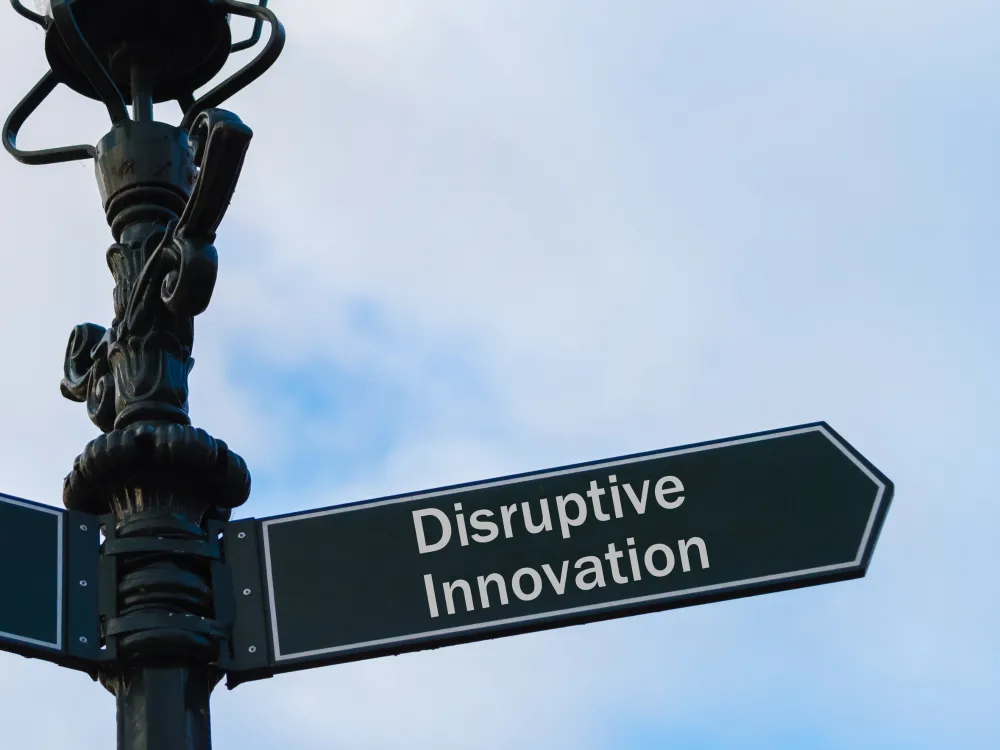
A street sign labeled "Disruptive Innovation" mounted on a decorative lamppost against a blue sky backdrop.
Schumpeterian Growth and Disruptive Innovation in the Education Sector
Joseph Schumpeter pointed out that the economic development process is neither smooth nor linear but disruptive and cyclical in nature. His theory of creative destruction—the perpetual displacement of old technologies and institutions by newer, better ones—remains central to any understanding of innovation-led growth. Nowhere is this process more visible today than in the education sector, where development efforts of education software are deconstructing traditional pedagogical models and creating novel forms of knowledge production and dissemination.
It highlights the synergistic relationship between Schumpeterian growth, technological disruption in education, and the role disruptive software solutions play in transforming and ultimately delivering education through digital means. Through the lens of economics, we examine the ramifications of these innovations for productivity, accessibility, and long-term growth.
Creative Destruction in the Education Sector
For centuries, the traditional education model has remained fixed on physical classrooms, standard curricula, and one-size-fits-all delivery methods. Though effective in its time, this model has in many cases turned out to be resistant to change. But, recent developments in technology—especially digital software—seem to have sparked a Schumpeterian cycle of disruption.
That data is decisive, because education software solutions have facilitated personalized learning pathways, real-time performance monitoring, gamification of learning in classrooms, and virtual collaboration. All of these have already started replacing textbooks, the static assessments, and even the need to physically attend educational institutions. In true Schumpeterian fashion, these digital solutions not only enhance existing methods; they make them redundant.
The Role of Innovation and R&D in Education Software Development
Central to this upheaval is, of course, the software development for education, a burgeoning domain that shows the movement from traditional forms of delivery to scalable and highly efficient educational systems. Companies that specialize in such development—like Inoxoft—build platforms that allow both institutions and learners to break the barriers of time and space, fundamentally rediscovering new aspects of education.
The shift is not merely technological but economic. Over the last decade, investment in education-focused research and development (R&D) has skyrocketed, in parallel with an explosion of EdTech start-ups and venture capital into the sector. These investments produced not just products, but whole ecosystems for collaborative learning, curriculum customization, and artificial intelligence-driven instruction.
Empirical Trends: EdTech Startups and Market Displacement
This graph below shows how the number of EdTech startups founded across the globe inversely correlates with physical textbooks revenues decline from the last decade. The downward line visually embodies Schumpeter’s fundamental argument: as new firms move into the marketplace to meet demands in new ways, older firms and methods fall out of favor.
This trend does not suggest the complete disappearance of traditional institutions, but rather that the monopoly of their dominance is gently disrupted in favor of more agile, tech-enabled, more lateral alternative methods. Education software companies fulfill the role of “innovating entrepreneurs” in Schumpeter’s model—sparking technological transformation and forcing society into the next growth cycle
Disruption and the Labor Market
In addition to institutional disruption, digital disruption of education has important implications for the labor market. The connection between formal degrees and employability is weakening as software tools facilitate more rapid and custom upskilling. Certifications, micro-credentials, and self-paced learning—often powered by software platforms—are now legitimate signals of skill and competency in the marketplace.
This evolution can increase fluidity and responsiveness within labor markets. As a result, it creates a positive externality: the more people are able to pursue nontraditional pathways to education thanks to software, the more demand there is for platforms that can accommodate more diverse learning paths, driving more investment and innovation in the development of education software.
Implications for Long-Term Growth
From a macroeconomic perspective, what this means for the future of the education sector in the digital age is highly significant. By removing barriers to skill acquisition and supporting lifelong learning, education software can improve the average productivity of the labor force. Further, by expanding access to high-quality instruction across geographies, it reduces educational inequality—a persistent drag on human capital formation and economic efficiency.
In this Schumpeterian framework, each wave of innovation is accompanied by an adjustment and dislocation phase, but then the economy settles into a new equilibrium with higher levels of productivity and output. The recent one spearheaded by EdTech is no exception. New technologies threaten incumbents to make way for newer but can also open up for more dynamic, inclusive and resilient educational ecosystems.
Conclusion
What we are witnessing is a paradigm shift in education—not an incremental reform, but a disruptive innovation aligned with Schumpeter-style economic growth. At the center of this change lies education software development—an engine of technological and institutional renewal.
Both education and economic possibility are being transformed, as traditional knowledge delivery systems cede to increasingly scalable, customized, and AI-enabled platforms. These shifts don’t come without their challenges, especially around regulation, equity, and institutional inertia. But the overall trajectory is clear: in the cycle of creative destruction, education software isn’t just a means to a more effective learning experience—it is a service on the road to sustained, innovation-driven growth.


